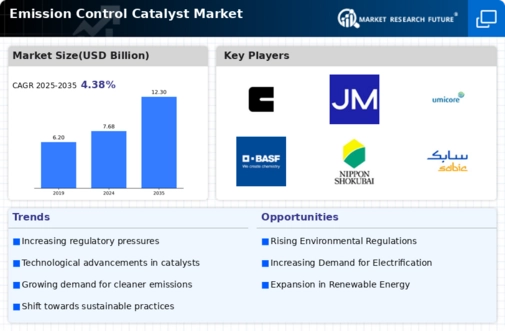Top Industry Leaders in the Emission Control Catalyst Market

The emission control catalyst market, a lynchpin in curbing air pollution from vehicles and industries, is experiencing a surge fueled by stringent emission regulations and the rising tide of environmental consciousness. These catalysts, composed of precious metals and engineered zeolites, play a crucial role in transforming harmful pollutants like nitrogen oxides and hydrocarbons into harmless water vapor and carbon dioxide. This market presents both opportunities and challenges for established players and aspiring contenders.
Key Strategies Shaping the Market:
-
Product Diversification: Leading companies like Johnson Matthey, BASF, and Umicore are expanding their catalyst portfolios, tailoring formulations to specific engine types and emission standards. This differentiation caters to diverse applications and strengthens customer loyalty. -
Technological Advancements: Continuous research and development in catalyst materials, manufacturing processes, and simulation technologies are crucial for sustained growth. Clariant's recent breakthrough in developing low-platinum catalysts exemplifies this commitment to innovation. -
Vertical Integration: Securing control over upstream resources like precious metals is essential for ensuring stable supply chains and cost competitiveness. Companies like Heraeus are actively pursuing vertical integration, gaining control over critical raw materials. -
Geographic Expansion: Emerging economies like China and India are witnessing rapid growth in vehicle production, increasing the demand for emission control catalysts. Companies like Corning Incorporated are strategically building production facilities in these regions to capitalize on the expanding market. -
Sustainability Focus: Environmental concerns surrounding the mining and processing of precious metals are pushing manufacturers towards sustainable alternatives. Solvay's focus on using recycled materials in their catalysts demonstrates this commitment to green practices.
Factors Dictating Market Share:
-
Brand Reputation and Reliability: Established players with proven track records like Tenneco and Cataler enjoy significant market share due to their brand recognition and consistent quality. However, innovative startups addressing specific niche applications can carve out their space. -
Cost Competitiveness: Optimizing production processes and sourcing affordable raw materials are crucial for cost leadership. Asian manufacturers often have an edge due to lower labor costs, but premium brands command higher prices due to superior performance and reliability. -
Distribution Network and Customer Service: Extensive distribution networks and prompt technical support are essential for customer satisfaction and repeat business. Companies like CORMETECH excel in this area. -
Regulatory Landscape: Stringent emission standards like Euro 7 and Bharat Stage VI are pushing manufacturers to develop catalysts with enhanced efficiency and lower emissions. Adapting to evolving regulations and developing compliant products becomes crucial for market success.
Key Players:
- BASF SE (Germany)
- Johnson Matthey (U.K.)
- Solvay (Belgium)
- Umicore SA (Belgium)
- Corning Incorporated (U.S.)
- Clariant (Switzerland)
- aerinox-inc (U.S.)
- CORMETECH, INC. (U.S.)
- Cataler Corporation (Japan)
- DCL International Inc (U.S.)
Industry News and Recent Developments:
August 2023: The California Air Resources Board (CARB) proposes even stricter emission standards for heavy-duty trucks, requiring more advanced catalyst technologies, boosting demand in this segment.
September 2023: Johnson Matthey partners with a leading electric vehicle manufacturer to develop next-generation emission control catalysts for fuel cell vehicles, preparing for the shift towards electric mobility.
October 2023: The Chinese government announces plans to invest in upgrading industrial emission control systems, leading to increased demand for industrial catalysts.
November 2023: The European Union proposes a ban on the use of certain toxic materials in catalysts, posing a challenge for traditional manufacturers but pushing development of safer alternatives.
December 2023: A consortium of leading catalyst manufacturers announces the formation of a research alliance to develop sustainable and cost-effective production methods for precious metal recovery and recycling.

